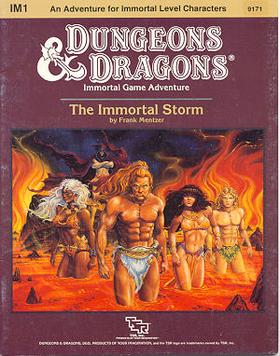 | |
| Code | IM1 |
|---|---|
| TSR product code | 9171 |
| Authors | Frank Mentzer |
| First published | 1986 |
The Immortal Storm is a 1986 adventure module for the Immortals Rules expansion to the Basic Rules of the Dungeons & Dragons fantasy role-playing game.
 | |
| Code | IM1 |
|---|---|
| TSR product code | 9171 |
| Authors | Frank Mentzer |
| First published | 1986 |
The Immortal Storm is a 1986 adventure module for the Immortals Rules expansion to the Basic Rules of the Dungeons & Dragons fantasy role-playing game.
The Immortal Storm is a scenario for novice Immortal-level characters. Immortals from the five spheres of power (matter, energy, thought, time, and entropy) must stop a cosmic storm. To do so, the characters must quest through the planes to obtain the Key to Eternity. [1]
A supernatural storm threatens the entire multiverse. Mysteriously, a supernatural eye sits in the center of the storm watching the Hierarchs, who cannot dissipate the storm. [2] Nix, the Hierarch of Entropy, wants the player characters' help to rid the multiverse of the malignant maelstrom that threatens all of space and time. [3] At last, the eye gives the Hierarchs a puzzle, which they use to test the player characters to determine their fitness for the mission. By solving the puzzle, characters learn their roles in the quest. Having solved the puzzle themselves, the Hierarchs impart this knowledge to characters regardless of their performance. [2]
The party then seeks necessary items in the planes; searches in New York and Chicago precede the climax. [2] When the Immortals visit the plane of technology, their powers cannot help them. [3] At the conclusion, the characters guard the Hierarchs as they destroy the storm. [2]
The Immortal Storm is a 40-page booklet with an outer folder, published in 1986. It was written by Frank Mentzer, with cover art by Larry Elmore and interior art by Valerie Valusek and Larry Elmore. [4] This module was the first produced for the D&D Immortals Rules set, designed for a party of Novice Temporals, the lowest level of Immortal character. [2]
In his review for White Dwarf , Graeme Davis compared the premises of The Immortal Storm and Star Trek: the Motion Picture , noting logical flaws: "everybody knows Our Heroes will get the mission no matter how badly they do [on the test]"; the storm lists the things needed to destroy it. [2] Davis found the different planes' presentation imaginative, despite a plane consisting entirely of music staves and populated by sentient musical notes that "smacks more of Dr. Seuss than D&D". [2] He further criticized the air-filled tunnels in the Plane of Earth that help its inhabitants move about, and ridicules the adventure's climax: "Our Heroes happen to need something from this humble little plane of ours, and as everybody knows, if it's vital to the survival of the multiverse, well gee whiz, it's just gotta be in the USA. I must admit, though, having an inter-planar gate on the New York subway might explain a thing or two." [2] Davis felt that newly-Immortal characters' powers were "severely wasted by sending them on a trip down the shops. I'm sure that it would have been possible to come up with something a little more grand in scale for the first Immortals module." [2] He claimed to sense a hurried quality about the module's production, concluding that "the module does have its moments, but my overall impression was one of disappointment". [2]
Tom Zunder reviewed The Immortal Storm for the British magazine Adventurer #6 (January 1987). [3] He commented on the cover art, recalling the cover of Day of Al'Akbar , saying "here we at last have a sexy elf and a hunky bloke to go with the bosom brigade. Can't really complain about this cover too much really, the molten lava they walk around in almost-naked does after all give a hint as to the magnitude of adventure to expect. This is, after all, the first of the Immortal scenario packs, and we're all expecting something rather epic. We are not to be disappointed". [3] He commented on the scope of the adventure: "A solution of riddles, the Immortals game takes D&D to its ultimate conclusion, magic and technology become truly intermingled in the mechanics of D&D sorcery. The strange thing is, that when [player characters] can transfer across the planes, pluck starfire from flaming suns and use wishes like ship computers, it all becomes absolutely excellent fun. The setting is so cosmic, it's a totally different game, and a very appealing one." [3] He called the Immortals' visit to the "dour" plane of technology "one of the best bits of the adventure" and noted that "New York City is a dangerous place for stranded Immortals". [3] Zunder concluded the review by saying: "Frank Mentzer has come up with a really good one here, a scenario so far beyond Basic D&D as to really be a totally different game and setting altogether. I wasn't expecting to enjoy this, but I found the ideas really good fun and was tempted to go and play the game really and properly.... I guess that's a yes for the Immortal D&D owners, and a suggestion to the lower levels that they might skip the intermediate stuff altogether and have an ogle at this little lot". [3]
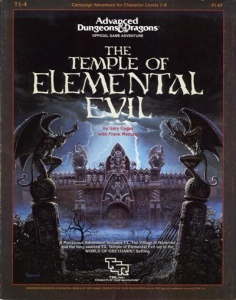
The Temple of Elemental Evil is an adventure module for the fantasy role-playing game Dungeons & Dragons, set in the game's World of Greyhawk campaign setting. The module was published by TSR, Inc. in 1985 for the first edition Advanced Dungeons & Dragons rules. It was written by Gary Gygax and Frank Mentzer, and is an expansion of an earlier Gygax module, The Village of Hommlet. The Temple of Elemental Evil is also the title of a related 2001 Thomas M. Reid novel and an Atari computer game.
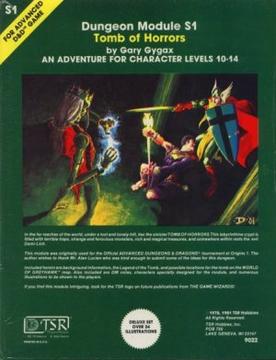
Tomb of Horrors is an adventure module written by Gary Gygax for the Dungeons & Dragons (D&D) role-playing game. It was originally written for and used at the 1975 Origins 1 convention. Gygax designed the adventure both to challenge the skill of expert players in his own campaign and to test players who boasted of having mighty player characters able to best any challenge. The module, coded S1, was the first in the S-series, or special series of modules. Several versions of the adventure have been published, the first in 1978, and the most recent, for the fifth edition of D&D, in 2017 as one of the included adventures in Tales from the Yawning Portal. The module also served as the basis for a novel published in 2002.

Day of Al'Akbar is an Advanced Dungeons & Dragons adventure module written by Allen Hammack and published by TSR inc. in 1986. The module consists of a forty-page booklet with a large color map and an outer folder. It bears the Dungeons & Dragons code I9, I meaning intermediate and 9 for module 9 in that series.

D&D Adventurers League, or simply Adventurers League for short, is the organized play association for the Dungeons & Dragons (D&D) roleplaying game which is officially administered by D&D's publisher, Wizards of the Coast. Prior to 2014, it was known as the Role Playing Game Association Network. The organization was originally established by D&D's previous publisher, TSR, Inc., in 1980.

Player Character Record Sheets is an accessory designed for the tabletop fantasy role-playing game Dungeons & Dragons.

Jacob Franklin Mentzer III is an American fantasy author and game designer who worked on early materials for the Dungeons & Dragons (D&D) fantasy role-playing game. He was an employee of TSR, Inc. from 1980 to 1986, spending part of that time as creative advisor to the chairman of the board, Gary Gygax. He also founded the Role-Playing Games Association (RPGA) during his time with TSR.

The Isle of Dread is an adventure for the Dungeons & Dragons role-playing game. The adventure, module code X1, was originally published in 1981. Written by David "Zeb" Cook and Tom Moldvay, it is among the most widely circulated of all Dungeons & Dragons adventures due to its inclusion as part of the D&D Expert Set. In the adventure, the player characters search for a lost treasure, journey to the prehistoric Isle of Dread, and there meet new nonhuman races.
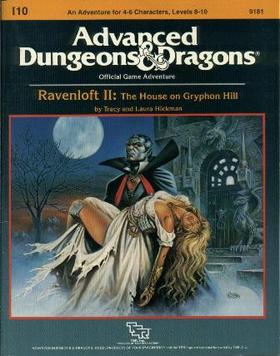
Ravenloft II: The House on Gryphon Hill is a Dungeons & Dragons module written for use with the First Edition Advanced Dungeons & Dragons ruleset, by TSR.
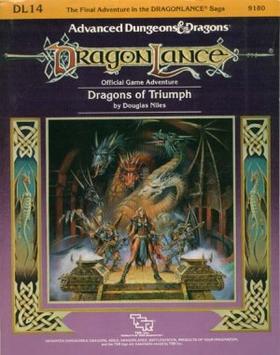
Dragons of Triumph is the fourth and final module in the third story arc of the 14-module Dragonlance (DL) series of the Dungeons & Dragons adventure role-playing game. The series was published by TSR between 1984 and 1986. The game's cover art work by Clyde Caldwell features Laurana Kanan chained on a platform before the goddess of evil, Takhisis.
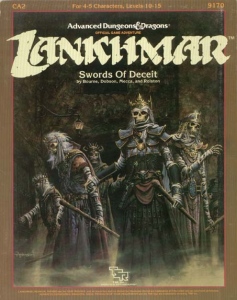
Swords of Deceit is a 1986 adventure module for the Advanced Dungeons & Dragons fantasy role-playing game, for the Lankhmar setting.

Night's Dark Terror is an adventure module for the Dungeons & Dragons (D&D) fantasy role-playing game written by British game designers Jim Bambra, Graeme Morris, and Phil Gallagher. It was designed specifically for campaigns transitioning from the D&D Basic Set to the D&D Expert Set. The player characters (PCs) journey from a farmstead into uncharted wilderness, where they encounter new hazards and contend with a secret society. The adventure received a positive review from White Dwarf magazine.

The Dungeons & Dragons Basic Set is a set of rulebooks for the Dungeons & Dragons (D&D) fantasy role-playing game. First published in 1977, it saw a handful of revisions and reprintings. The first edition was written by J. Eric Holmes based on Gary Gygax and Dave Arneson's original work. Later editions were edited by Tom Moldvay, Frank Mentzer, Troy Denning, and Doug Stewart.
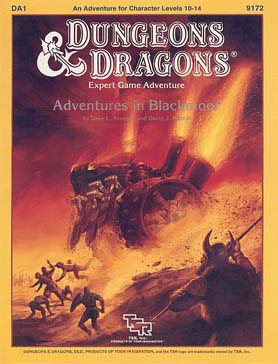
Adventures in Blackmoor is a 64-page Dungeons & Dragons fantasy role-playing game adventure, designed to be compatible with the Dungeons & Dragons Expert Set.

The Dungeons & Dragons Companion Set is an expansion boxed set for the Dungeons & Dragons (D&D) fantasy role-playing game. It was first published in 1984 as an expansion to the Dungeons & Dragons Basic Set.

Dungeons & Dragons Master Rules is an expansion boxed set for the Dungeons & Dragons (D&D) fantasy role-playing game. It was first published in 1985 as an expansion to the Basic Set.

Dungeons & Dragons Immortals Rules, written by Frank Mentzer, is a boxed set for the Dungeons & Dragons (D&D) fantasy role-playing game first published by TSR in 1986 as an expansion to the Basic Set.

The Expert Set is an expansion boxed set for the Dungeons & Dragons fantasy role-playing game. It was first published in 1981 as an expansion to the Basic Set.

Saga of the Shadow Lord is a 1986 adventure module for the Basic Rules of the Dungeons & Dragons fantasy role-playing game.
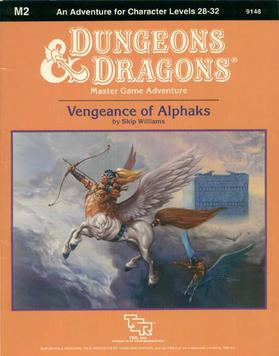
Vengeance of Alphaks is an adventure module for the Dungeons & Dragons fantasy role-playing game, set in that game's Mystara campaign setting. TSR, Inc. published the module in 1986 for the D&D Master Set rules. It is part of the "M" series of modules. The module was designed by Skip Williams. Its cover art is by Jeff Easley, with interior art by Mark Nelson and cartography by David C. Sutherland III.

Twilight Calling is an adventure module for the Dungeons & Dragons fantasy role-playing game, set in that game's Mystara campaign setting. TSR, Inc. published the module in 1986 for the D&D Master Set rules. It is part of the "M" series of modules. The module was designed by Tom Moldvay with additional design, development and editing by Bruce Heard, Karen Martin, Rick Swan, Jennell Jaquays, Kevin Stein and Robin Jenkins. Its cover art is by Ben Otero, with interior art by Larry Elmore and cartography by Diane & Dave Sutherland, Gloria Szopinski and Rob Peacock.